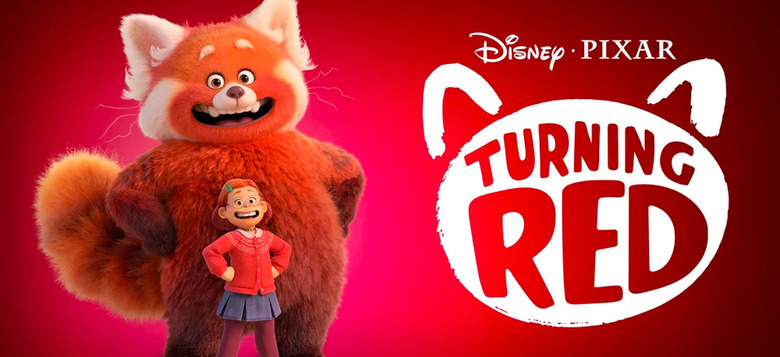

Turning Red is the newest animation released by Pixar. It features the story of Mei Lee, a Chinese-Canadian teenager who enters puberty and struggles to accept who she is becoming. While getting used to new facets of her identity, she tries to honour her parents but also enjoy an increasingly independent life with her close friends. One day, after an embarassing event involving her mother shouting at her crush in public, Mei is shocked to find out that she is capable of feeling very strong emotions. From then on, whenever she gets thrilled or furious, she doesn’t blush – way worse – she literally turns into a red panda, hence the title ‘Turning Red’.
Led by an all-women team who wanted to convey the experiences of being a teenage girl in the 2000s, the movie artfully depicts the hallmarks of early adolescence: the “best friends forever”, the crushes, the fangirling, the highest highs and the lowest lows, and most centrally, the conflicts with parents. Adolescence is the main theme of the movie, but the secondary theme is the experience of children whose parents are immigrants and continue to keep the traditions of their own culture in a new country. Different sub-plots make the story feel authentic and relatable. In the foreground, there’s Mei’s relationship with her friends and her parents, but many other important things happen: Mei’s mom’s relationship with her own mother, the clash between tradition and modernity in a family, Mei’s relationship with her father, and the story of a school bully who eventually becomes a good friend.
Mei is a confident, strong-willed girl and a loyal friend. She is an excellent student and has always done what her parents wanted her to. At thirteen years old, she feels very close to her group of friends and is lucky to have them support her unconditionally, bringing emotional balance into her life. Things couldn’t get better in her social life, but Mei’s relationship with her family, especially her mother, becomes tenser. When Mei can’t but turn into a red panda whenever she feels strong emotions, her family tries to make the red panda go away. This crisis takes the central place in the movie and is decisive for how Mei will eventually find a balance between family and friends, and deal with her new intense emotions.
The movie is a well-thought-out blend of heart-warming, but not derogatory stereotypes about adolescence and what actually happens in reality. For example, it is often thought that friends in adolescence have a bad influence, and that groups of adolescents usually take too many risks with serious negative consequences. Turning Red shows that good friends are crucial for the development of adolescents and their influence is rather positive. Mei’s friends support her unconditionally, they understand her and encourage her to be bold and stand for herself. When she turns into a red panda, they stand by her side and teach her to see the positive sides of it. By accepting Mei even when her emotions are out of control, they teach Mei to be tolerant with her new self and they make it easier for her to be comfortable in her skin.
Another interesting part is the relationship between Mei and her mother. While adolescents have a reputation for being irrational, impulsive, and rebellious against their parents (which is not entirely true according to research), the depiction of mother-child relationships during adolescence is more nuanced in Turning Red. In their arguments, both Mei and her mother are right and wrong in some respect. It is not only the adolescent who is struggling with her identity, but also her parents. Last but not least, the story highlights that the strong emotions felt by adolescents can be felt by anyone and that it is each person’s decision what to do with them: control them and extinguish them, or harness them and turn them into something advantageous.
Turning Red beautifully continues Pixar’s trend of making animations that are profound and meaningful, that contain many lessons for children and their parents, and that normalize the messy parts of being human. The characters in Turning Red have unique, well-rounded personalities. They experience situations that many of us can relate to – well, except literally turning into a red panda. They have different body shapes and skin colours. They feel real and their actions encourage the viewers to put themselves in their shoes and see the world from their perspective. That is what makes Turning Red enjoyable and educational for any age. It is hard to find any downside of the movie. I definitely recommend watching it, and even watching it several times – there is so much to discover, be it a subtle message you did not catch from the start, or some fine detail in the construction of the characters that makes you resonate more with the story. You’ll be sure to leave the cinema willing to hug your own inner red panda as well.
Directed by: Domee Shi

Turning Red is the newest animation released by Pixar. It features the story of Mei Lee, a Chinese-Canadian teenager who enters puberty and struggles to accept who she is becoming. While getting used to new facets of her identity, she tries to honour her parents but also enjoy an increasingly independent life with her close friends. One day, after an embarassing event involving her mother shouting at her crush in public, Mei is shocked to find out that she is capable of feeling very strong emotions. From then on, whenever she gets thrilled or furious, she doesn’t blush – way worse – she literally turns into a red panda, hence the title ‘Turning Red’.
Led by an all-women team who wanted to convey the experiences of being a teenage girl in the 2000s, the movie artfully depicts the hallmarks of early adolescence: the “best friends forever”, the crushes, the fangirling, the highest highs and the lowest lows, and most centrally, the conflicts with parents. Adolescence is the main theme of the movie, but the secondary theme is the experience of children whose parents are immigrants and continue to keep the traditions of their own culture in a new country. Different sub-plots make the story feel authentic and relatable. In the foreground, there’s Mei’s relationship with her friends and her parents, but many other important things happen: Mei’s mom’s relationship with her own mother, the clash between tradition and modernity in a family, Mei’s relationship with her father, and the story of a school bully who eventually becomes a good friend.
Mei is a confident, strong-willed girl and a loyal friend. She is an excellent student and has always done what her parents wanted her to. At thirteen years old, she feels very close to her group of friends and is lucky to have them support her unconditionally, bringing emotional balance into her life. Things couldn’t get better in her social life, but Mei’s relationship with her family, especially her mother, becomes tenser. When Mei can’t but turn into a red panda whenever she feels strong emotions, her family tries to make the red panda go away. This crisis takes the central place in the movie and is decisive for how Mei will eventually find a balance between family and friends, and deal with her new intense emotions.
The movie is a well-thought-out blend of heart-warming, but not derogatory stereotypes about adolescence and what actually happens in reality. For example, it is often thought that friends in adolescence have a bad influence, and that groups of adolescents usually take too many risks with serious negative consequences. Turning Red shows that good friends are crucial for the development of adolescents and their influence is rather positive. Mei’s friends support her unconditionally, they understand her and encourage her to be bold and stand for herself. When she turns into a red panda, they stand by her side and teach her to see the positive sides of it. By accepting Mei even when her emotions are out of control, they teach Mei to be tolerant with her new self and they make it easier for her to be comfortable in her skin.
Another interesting part is the relationship between Mei and her mother. While adolescents have a reputation for being irrational, impulsive, and rebellious against their parents (which is not entirely true according to research), the depiction of mother-child relationships during adolescence is more nuanced in Turning Red. In their arguments, both Mei and her mother are right and wrong in some respect. It is not only the adolescent who is struggling with her identity, but also her parents. Last but not least, the story highlights that the strong emotions felt by adolescents can be felt by anyone and that it is each person’s decision what to do with them: control them and extinguish them, or harness them and turn them into something advantageous.
Turning Red beautifully continues Pixar’s trend of making animations that are profound and meaningful, that contain many lessons for children and their parents, and that normalize the messy parts of being human. The characters in Turning Red have unique, well-rounded personalities. They experience situations that many of us can relate to – well, except literally turning into a red panda. They have different body shapes and skin colours. They feel real and their actions encourage the viewers to put themselves in their shoes and see the world from their perspective. That is what makes Turning Red enjoyable and educational for any age. It is hard to find any downside of the movie. I definitely recommend watching it, and even watching it several times – there is so much to discover, be it a subtle message you did not catch from the start, or some fine detail in the construction of the characters that makes you resonate more with the story. You’ll be sure to leave the cinema willing to hug your own inner red panda as well.
Directed by: Domee Shi



